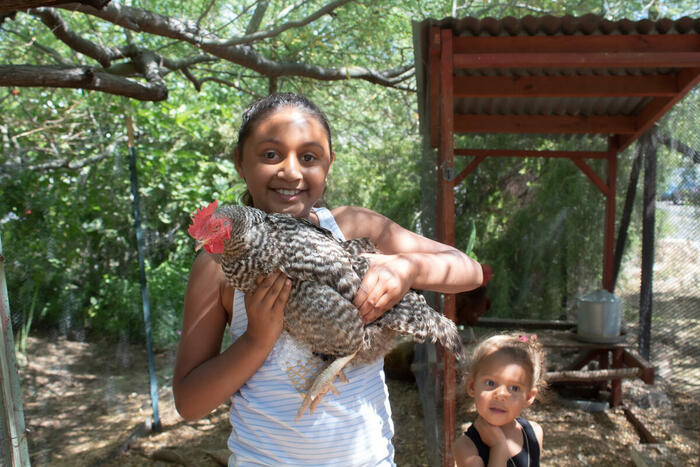Family Saturday: What are native edible plants?
Gracie Kayko, Environmental Journalism Intern - June 24, 2024
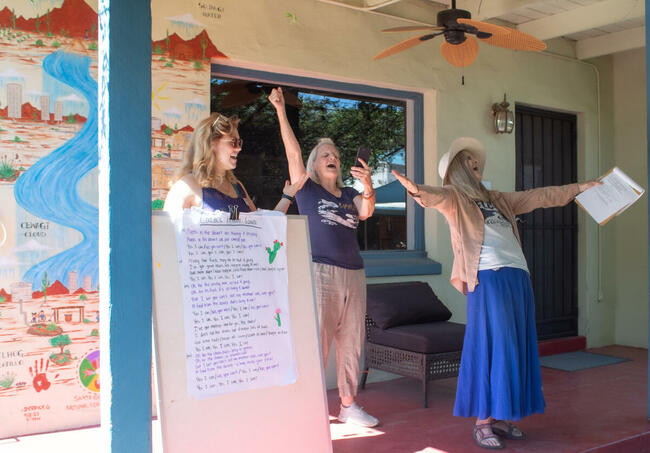 On the third Saturday of the month, Family Saturday is held at Watershed Management Group’s Living Lab.
On the third Saturday of the month, Family Saturday is held at Watershed Management Group’s Living Lab.
Family Saturday is a free, educational event that invites families to come learn about a variety of sustainability-focused topics around living respectfully with the resources in the Sonoran Desert. On May 18th, families came to learn about native edible plants.
Starting at 8 a.m., the first hour and a half of the event is dedicated to nature activities. Volunteers and staff educate the families on the Living Lab, showing off the site's sustainable living practices. The Living Lab, WMG’s headquarters, is a public demonstration site showing how to live “hydrolocal” - that is learning to live with the water we receive in Tucson from snow melt, rain, stormwater and greywater, reducing dependency on the distant Colorado River and depletion of our local groundwater.
Four kid-friendly activities were set up around the patio and in the Learning Center; rock polishing, native edible coloring sheets, a native edible food station, and CoderDojo, a computer exploration with volunteer Dan Stormont.
Docents lead everybody in song
CoderDojo, a non-profit, volunteer-led foundation, is a global network of “dojos” that teach kids ages 7 to 17 how to code, build websites, and create apps and games. Dan started CoderDojo Tucson in 2015 and includes content for teens and tweens at Family Saturdays. The activities vary, but relate to the theme of Family Saturday.
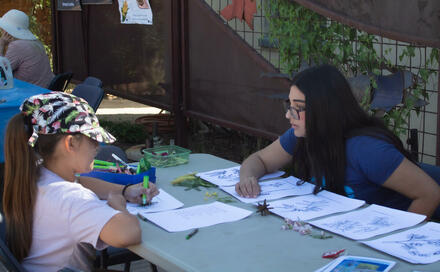 To go along with the theme of native edible plants, Dan had scratch games for plant and tree placement in a rainwater harvesting basin and the Tohono O’odham planting calendar, a concentration card game based on the LLLC, a commercial animals of the Sonoran Desert game, and prototype of a set building game for rainwater harvesting.
To go along with the theme of native edible plants, Dan had scratch games for plant and tree placement in a rainwater harvesting basin and the Tohono O’odham planting calendar, a concentration card game based on the LLLC, a commercial animals of the Sonoran Desert game, and prototype of a set building game for rainwater harvesting.
After families spent time exploring the site, everyone gathered for a song and story time. Volunteer docents, Laurel Pollard and April Lewis performed a song celebrating native edible desert plants. As part of the Family Saturday team Laurel and April help to provide fun, experiential ways to get children and their families learning about living respectfully with the Sonoran Desert. Laurel, who writes and performs many of the songs used at Family Saturdays, said, “For me, it’s a pleasure to find fun facts and create rhymes.”
Coloring on native edible plant coloring sheets
In the last verse of the song, April, who was at first skeptical of eating desert food, begins to see why native foods are so great and is praised for it. The two leave the stage, arm in arm, to enjoy a breakfast of desert plants.
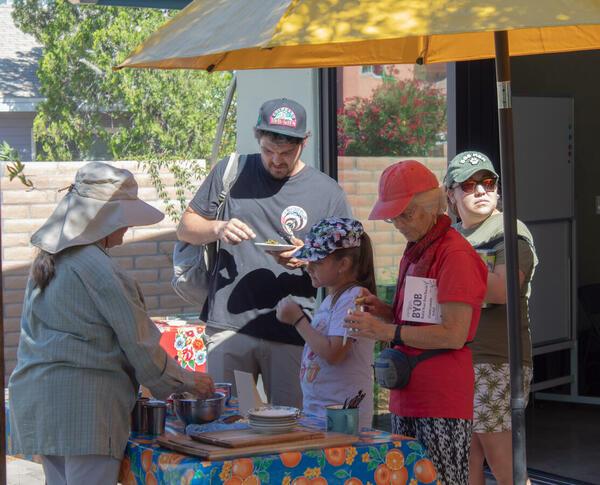 After the show, people participated in the activity stations and tasted homemade desert food made by Catherine Evilsizor. Catherine has been volunteering with WMG for a couple of years now, and offered to bring native edibles that she was familiar with and was able to harvest in time for Family Saturday.
After the show, people participated in the activity stations and tasted homemade desert food made by Catherine Evilsizor. Catherine has been volunteering with WMG for a couple of years now, and offered to bring native edibles that she was familiar with and was able to harvest in time for Family Saturday.
She set up her dishes on a shaded table outside of the Learning Center, where Julie Regalado, WMG’s Education Program Director, cooked nopales, also known as prickly pear pads, next to her.
Catherine’s native edible spread included; mesquite bean flour, cookies made with mesquite flour and sweetened with agave syrup, slices of lemony barrel cactus fruit with its crunchy black seeds, palo verde beans that were blanched, removed from the pod, and frozen in a jar from last year, and desert willow flower sun tea.
She harvested the food from her neighborhood, a friend's house, and from a pocket park in Tucson. Catherine has been eating native edibles her whole life, and learned to cook them from other people and books.
Both children and their adults tried the desert dishes, took part in rock polishing, and hung out in the chicken coop. It was a successful, fun, and educational day. Families try native edible dishes
Upcoming Events
The next Family Saturday will be on July 20th, at 6 p.m. at the Living Lab. Families will get to celebrate the monsoon season, learn about nocturnal animals of the Sonoran Desert, hear a story time and get creative with monsoon-related activities!
CoderDojo is having a workshop this month at the Living Lab! Join Dan on the week of June 24th to learn more about native trees and plants. Learn more about CoderDojo here.
Kids play with the chickens in the chicken coop
Interns experience: Trying native edibles for the first time
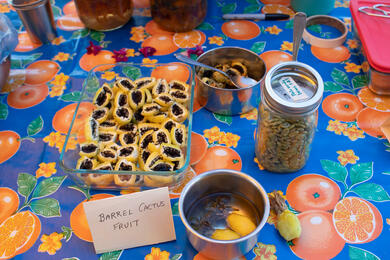 I myself tried my first desert food at this Family Saturday. I started my internship with WMG in the middle of April, and I already feel I’ve learned so much about native edibles, but I know I have much more to discover.
I myself tried my first desert food at this Family Saturday. I started my internship with WMG in the middle of April, and I already feel I’ve learned so much about native edibles, but I know I have much more to discover.
When I saw Catherine prepare an array of dishes for people to try, I knew it was my lucky day. The first thing I wanted to try, and I think other kids were excited about, was the mesquite cookies. And let's just say, they did not disappoint!
I’m not one for a sweet tooth, I prefer savory over sweet, so when Catherine asked if I wanted one with or without sea salt, I chose the sea salt cookie. They tasted like any other, regular ingredient sugar cookie. Soft, sweet, and also salty.
Who doesn’t love a cookie? Especially when they look like something you’ve seen before. Barrel Cactus Fruit
My next dish was barrel cactus fruit. I was a little hesitant.
Trying new things can be scary for me, but everyone else was eating it with a smile on their faces, so I gave it a shot. And to my suprise, it turned out to be my favorite dish out of everything! It was sweet but tangy, with hits of citrus, and crunchy.
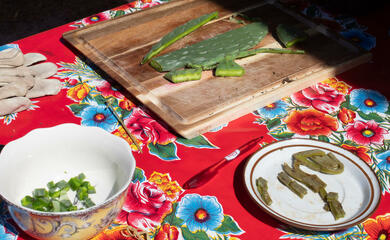 The last thing I had was nopales. Julie had harvested the plant that morning, making sure that it was fresh and ripe. Julie shaved off the spines of the pad, sliced them into small cubes, and cooked half of them on a hot pad. Everyone was invited to try a raw and cooked cube of nopales.
The last thing I had was nopales. Julie had harvested the plant that morning, making sure that it was fresh and ripe. Julie shaved off the spines of the pad, sliced them into small cubes, and cooked half of them on a hot pad. Everyone was invited to try a raw and cooked cube of nopales.
To me, the nopales tasted exactly like a green pepper, only a little… slimy.
Texture of food does not bother me, but if you don’t like slimy dishes, such as jello, the cooked nopales might be more appetizing.
Now that I know I like the food the desert provides us, I am excited to start incorporating native edibles into my diet!
Fresh & grilled nopales

